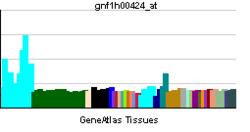- NKAP
-
NFKB activating protein Identifiers Symbols NKAP; FLJ22626 External IDs OMIM: 300766 MGI: 1914300 HomoloGene: 11570 GeneCards: NKAP Gene Gene Ontology Molecular function • chromatin binding
• protein bindingCellular component • nucleus
• nucleolus
• cytoplasmBiological process • Notch signaling pathway
• negative regulation of transcription, DNA-dependent
• positive regulation of alpha-beta T cell differentiationSources: Amigo / QuickGO RNA expression pattern 
More reference expression data Orthologs Species Human Mouse Entrez 79576 67050 Ensembl ENSG00000101882 ENSMUSG00000016409 UniProt Q8N5F7 Q9D0F4 RefSeq (mRNA) NM_024528 NM_025937.4 RefSeq (protein) NP_078804 NP_080213.3 Location (UCSC) Chr X:
119.06 – 119.08 MbChr X:
34.67 – 34.69 MbPubMed search [1] [2] NF-kappa-B-activating protein is a protein that in humans is encoded by the NKAP gene.[1][2]
References
- ^ Chen D, Li Z, Yang Q, Zhang J, Zhai Z, Shu HB (Oct 2003). "Identification of a nuclear protein that promotes NF-kappaB activation". Biochem Biophys Res Commun 310 (3): 720–4. doi:10.1016/j.bbrc.2003.09.074. PMID 14550261.
- ^ "Entrez Gene: NKAP NF-kappaB activating protein". http://www.ncbi.nlm.nih.gov/sites/entrez?Db=gene&Cmd=ShowDetailView&TermToSearch=79576.
Further reading
- Strausberg RL, Feingold EA, Grouse LH, et al. (2003). "Generation and initial analysis of more than 15,000 full-length human and mouse cDNA sequences". Proc. Natl. Acad. Sci. U.S.A. 99 (26): 16899–903. doi:10.1073/pnas.242603899. PMC 139241. PMID 12477932. http://www.pubmedcentral.nih.gov/articlerender.fcgi?tool=pmcentrez&artid=139241.
- Ota T, Suzuki Y, Nishikawa T, et al. (2004). "Complete sequencing and characterization of 21,243 full-length human cDNAs". Nat. Genet. 36 (1): 40–5. doi:10.1038/ng1285. PMID 14702039.
- Ghiorzo P, Mantelli M, Gargiulo S, et al. (2004). "Inverse correlation between p16INK4A expression and NF-kappaB activation in melanoma progression". Hum. Pathol. 35 (8): 1029–37. doi:10.1016/j.humpath.2004.02.017. PMID 15297971.
- Beausoleil SA, Jedrychowski M, Schwartz D, et al. (2004). "Large-scale characterization of HeLa cell nuclear phosphoproteins". Proc. Natl. Acad. Sci. U.S.A. 101 (33): 12130–5. doi:10.1073/pnas.0404720101. PMC 514446. PMID 15302935. http://www.pubmedcentral.nih.gov/articlerender.fcgi?tool=pmcentrez&artid=514446.
- Ballif BA, Villén J, Beausoleil SA, et al. (2005). "Phosphoproteomic analysis of the developing mouse brain". Mol. Cell Proteomics 3 (11): 1093–101. doi:10.1074/mcp.M400085-MCP200. PMID 15345747.
- Gerhard DS, Wagner L, Feingold EA, et al. (2004). "The Status, Quality, and Expansion of the NIH Full-Length cDNA Project: The Mammalian Gene Collection (MGC)". Genome Res. 14 (10B): 2121–7. doi:10.1101/gr.2596504. PMC 528928. PMID 15489334. http://www.pubmedcentral.nih.gov/articlerender.fcgi?tool=pmcentrez&artid=528928.
- Gevaert K, Staes A, Van Damme J, et al. (2006). "Global phosphoproteome analysis on human HepG2 hepatocytes using reversed-phase diagonal LC". Proteomics 5 (14): 3589–99. doi:10.1002/pmic.200401217. PMID 16097034.
- Rual JF, Venkatesan K, Hao T, et al. (2005). "Towards a proteome-scale map of the human protein-protein interaction network". Nature 437 (7062): 1173–8. doi:10.1038/nature04209. PMID 16189514.
- Olsen JV, Blagoev B, Gnad F, et al. (2006). "Global, in vivo, and site-specific phosphorylation dynamics in signaling networks". Cell 127 (3): 635–48. doi:10.1016/j.cell.2006.09.026. PMID 17081983.
- Zhande R, Karsan A (2007). "Erythropoietin promotes survival of primary human endothelial cells through PI3K-dependent, NF-kappaB-independent upregulation of Bcl-xL". Am. J. Physiol. Heart Circ. Physiol. 292 (5): H2467–74. doi:10.1152/ajpheart.00649.2006. PMID 17237249.
Categories:- Human proteins
- Chromosome X gene stubs
Wikimedia Foundation. 2010.
